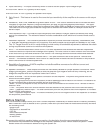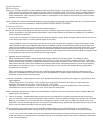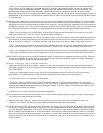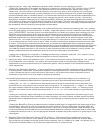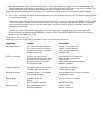• GND: This is the ground connection for the amplifi er and must be connected directly to the metal chassis
of the vehicle for the amplifi er to operate properly. A properly grounded amplifi er can be run harder and
longer than a poorly grounded amplifi er. The ground on the amplifi er should be as short as possible and
be connected directly to the vehicle’s metal chassis. Do not connect to factory bolts of ANY kind. When
attaching the ground to the chassis, sand all the paint away from the contact point. A grounding block like the
StreetWires GT4 should be used whenever possible as this piece of equipment has 5 times the surface area of
a normal screw.
The gauge of the power and ground wire is often an overlooked aspect of amplifi er installation. The more power
the amplifi er receives, the more power it will produce. Power cables have a natural resistance, and will lose
voltage by the time the power makes its way to the amplifi er. The larger gauge (diameter) wire will hold more
voltage over longer runs. Also, by having a larger diameter ground wire, the amplifi er can run more effi ciently.
MTX recommends using a minimum of 4 gauge power and ground cables to get the best performance.
• REM: This connection turns the amplifi er on and off and needs to be connected to a remote turn-on wire
from your source unit if you are using a low level input connection.
Note: When numerous amplifi ers are used in the same system, look into using a relay with a separate power wire
connected to an alternative power source to take the strain off the source unit. Normal source units can only
keep a constant 12 volts to 2 or possibly 3 amps. This wire should also be run away from the RCA cables.
• CAP+: This 8 gauge terminal is internally wired in parallel with the +12V on the StreetWires power connector.
It is the ideal connection point for the positive side of a capacitor to increase the amplifi er’s performance.
• CAP-: This 8 gauge terminal is internally wired in parallel with the GND on the StreetWires power connector.
It is the ideal connection point for the negative side of the capacitor to increase the amplifi er’s performance.
Double check all the previous connection installation steps, in particular the speaker and power wiring. Securely
mount the amplifi er. If everything is in order, reconnect the vehicle’s negative battery connection and begin
following the feature setup and adjustment steps.
Feature Setup and Adjustments
1. Selecting the Input Sensitivity Range – Before you turn on your system, you must select the proper input
sensitivity range on your amp using the button labeled INPUT SENS located in the GAIN CONTROL section of
the control panel.
• Setting for Aftermarket Source Units: Refer to your aftermarket owner’s manual for line level output
specifi cation. If the specifi cation is not available, please follow the instructions listed below.
X1 POSITION: 100mV–1V (Typically for RCA Input)
• Setting for Factory (OEM) Source Units: To check the amount of voltage that is present from the source
unit, take a multi meter, or a volt/ohm meter, on the AC setting, (range from 100mV up to 10 volts) attach the
positive and negative leads directly to any exposed speaker. It will not matter if the polarity is correct, it will
read the same amount of voltage.
X10 POSITION: 1V–10V (Typically for Speaker Level Input)
Note: It is important not to have the amp set up to receive a low voltage signal and give it a high voltage signal.
Doing this can cause damage to the amp.
2. Adjusting the Gain Control – Before you start setting your amp gains, be sure to defeat all EQs (“off”
position). You want to set the gain levels properly BEFORE applying any equalization.
Start with the source unit’s volume around ¾ of the way up, and the gain on the amp all the way down (counter-
clockwise). Slowly increase the gain clockwise until the speaker starts to distort. Immediately decrease gain
until the distortion goes away. This will be a good reference point on the volume control to where the signal
starts to distort. Remember every CD will be different; use common sense and constantly listen for obvious
distortion and adjust volume accordingly. The gain on the amp has nothing to do with how much power the
amp can produce, just how fast the amp puts out max power. Just like in an automobile, full throttle is very
rarely needed.




